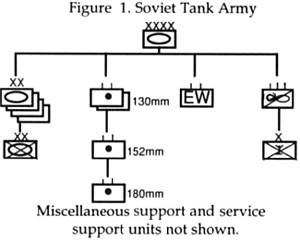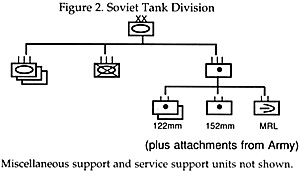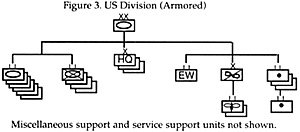Players may enjoy DRIVE ON FRANKFURT more if they understand the makeup of each unit and the organizations within which the units fight. This article will outline what each playing piece represents and the higher formations into which they are organized.
Soviet Formations
 Figure 1. Soviet Tank Army: Miscellaneous support and service support units
not shown.
Most of the Soviet units in the game belong to the First
Guards Tank Army. An Army's basic maneuver formation is the
division and a Soviet Army consists of four or five divisions plus
artillery, electronic warfare, and other assets. (see Figure 1). A Tank
Army has tank divisions with a single motor-rifle division; in an
AllArms army (i.e. infantry), the reverse is true.The army is
organized to fight in the Soviet system of two echelons: it leads with
one echelon of two or three divisions and follows up with the
remainder.
Figure 1. Soviet Tank Army: Miscellaneous support and service support units
not shown.
Most of the Soviet units in the game belong to the First
Guards Tank Army. An Army's basic maneuver formation is the
division and a Soviet Army consists of four or five divisions plus
artillery, electronic warfare, and other assets. (see Figure 1). A Tank
Army has tank divisions with a single motor-rifle division; in an
AllArms army (i.e. infantry), the reverse is true.The army is
organized to fight in the Soviet system of two echelons: it leads with
one echelon of two or three divisions and follows up with the
remainder.
Each army belongs to a higher organization called a Front. The Front possesses important assets - artillery, airmobile troops and air support -which it attaches to individual armies as it sees fit. The army repeats this pattern, attaching some of its units to individual divisions, while keeping others under its direct control.
Each division possesses four regiments (see Figure 2). A tank division has three tank and one motor-rifle regiment; a motor rifle division has the opposite. The division is organized to fight in two echelons with two regiments in each. The structure of each type of division is basically the same, except that a motor-rifle division has an additional tank battalion. This independent tank battalion - 66% stronger than an ordinary tank battalion represents the divisional commander's ultimate reserve. When all seems lost, he is supposed to lead this battalion into battle, seeking victory or death.
 Figure 2. Soviet Tank Division. Miscellaneous support and service
support units not shown.
Figure 2. Soviet Tank Division. Miscellaneous support and service
support units not shown.
Soviet organization represents a careful balance of two principles;
- 1. Units are grouped at all levels into fixed combined
arms organizations. Even the infantry squad is a combination of
vehicle, rifle, anti-tank and anti-tank weapons. These
organizations are standardized to reduce command problems.
2. Each level of command possesses reserve units which can be used to reinforce success at the lower levels. Each commander is expected to use his assets to strengthen whatever subordinate unit is achieving the greatest success. If he fails to do so, he can expect to be stripped of his command, disgraced, and sent to a penal battalion as a private soldier.
Soviet Units
Most of the Soviet combat units represent tank or motor- rifle regiments. A Soviet regiment is a fixed organization - units are not cross-attached from regiment to regiment. Each regiment is a full combined arms force in itself, possessing tanks, infantry, artillery, and antiaircraft weapons, plus additional anti-tank weapons in some cases. All Soviet units in DRIVE ON FRANKFURT are "Category 1" units, meaning they receive the most modern equipment available.
Tank regiment: 95 T-80 Main Battle Tanks (MBT), 31 BMP-2 or BMP-3 Infantry Fighting Vehicles (IFV), 18 122mm self- propelled artillery pieces.
Motor-rifle regiment; 95 IFV or armored personnel carriers (APC), 41 tanks, 18 122mm self-propelled artillery pieces, 18502350 men. Generally, one out of three motor-rifle battalions per regiment have BMP IFVs and the rest will have BTR APCs.
Independent Tank Battalion: 51 MBTs.
Soviet artillery is organized into battalions of 18 guns each. Each regiment, division, army, and front has artillery assets. In combat, a commander at each level will keep some of his artillery under his direct control and down-attach some of it to the next lower level. He, in turn, will receive some assets form the next higher level.
In combat, artillery battalions are organized into "groups". A divisional commander will organize regimental artillery groups (RAGs), responding to the requests of one regiment. A RAG will consist of the regiment's own artillery, plus one or more battalions down-attached from the divisional assets. Divisional artillery groups (DAGs) conduct bombardment and support missions under the control of the division HQ. A DAG will consist of divisional artillery and battalions down-attached from the army. An army artillery group is organized the same way.
Number and makeup of groups is flexible. The commander at each level will create groups and assign battalions according to the specific mission. To keep things simple, and reduce the number of counters, DRIVE ON FRANKFURT assumes typical group makeups for the basic battle situation depicted in the game. The exact weapons in each battalion vary considerable from division to division; those listed below are typical example.
- RAG: Two 122mm battalions. One of these is the
regiment's organic battalion; the other is attached from division.
DAG: One multiple rocket launcher (MRQ battalion, one 152mm battalion, one 130mm battalion (down-attached from army).
AAG: One 152mm battalion, one 180mm battalion (downattached from Front), one 130mm battalion if not down- attached.
The "air assault brigade" in the game actually includes two formations: an air assault brigade of infantry and an attack helicopter regiment. Administratively, these are separate, but it was convenient for game purposes to represent them as a single formation. Both of these are front-level formations which the game assumes have been attached to the First Guards Tank Army for its mission. The air assault brigade's job is to hold important forward positions for a limited time - 12 to 24 hours - until friendly forces link up.
Helicopter unit: 16 Mi-24 or Mi-28 helicopter (total of 64 per regiment).
Airmobile battalions: The air assault brigade musters four infantry battalions, 64 BMD air transportable IFVs and 18 air transportable artillery pieces. The BMDs can be assigned to battalions according to mission and available lift. The game assumes that they have been equally divided among two battalions, producing two fully mechanized battalions and two foot battalions.
US Formations
 Figure 3. US Division (Armored)
Figure 3. US Division (Armored)
The basic US maneuver formation is the brigade, consisting of a brigade headquarters and three or four battalions. There is no distinction between "tank" and "infantry" brigades, as each brigade contains some battalions of each. A brigade contains no organic artillery. In principle, units can be transferred quickly from one brigade to another. However, it is doubtful this would be attempted even more doubtful that it would succeed - under the pressure of battle, so the game doesn't allow it.
Brigades are organized into divisions (see Figure 3). Each division includes three ground brigades, one air cavalry (helicopter) brigade, and four artillery battalions. The helicopters and artillery support all three ground brigades. The game counters include the 3rd Armored Division and one brigade of the 1st Infantry Division, the latter deployed from the United States.
Artillery is not permanently attached to any one brigade. Each battalion can answer requests from any brigade, arranged in priority order. However, a battalion is often ordered to "direct support" a particular brigade. This means that the battalion will answer fire requests from that brigade in preference to all others. The US believes that its artillery system - which allows any one spotter to call down the full weight of the division's artillery - is superior because of its flexibility. The Soviets believe it will produce chaos, especially under the pressure of jamming.
US Units
Most US units in the game are battalions, either tank, "mech" (mechanized infantry), or artillery. Battalions contain only one weapons system: tanks, infantry, or guns. It is possible that companies will be swapped to produce combined arms battalions. This idea was prominent some years ago, but more recen Army literature has discouraged it.
Tank battalion: 58 M1 Abrams MBTs.
Mech battalion: 54 M2 Bradley IFVs, 7 M3 Bradley cavalry vehicles, 696 men.
Artillery battalion: 24 155mm howitzers, or 12 8" howitzers plus 9 Multiple Rocket Launchers. (The US artillery units with the shorter ranges are the 155s.) The 155mm units usually support brigades directly, while the 8" howitzers and the rocket launchers bombard.
Helicopter unit: 7 AH-64 attack helicopters, plus supporting OH-58 observation helicopters. Helicopter units are called "squadrons" rather than battalions; three helicopter units in the game make up one squadron (total: 21 AH-64s and 13 OH-58s). The air cavalry brigade also includes small ground assets and transport helicopters, but these do not show up as units because of the game's scale.
Cavalry troop: 9 MBTs, 12 IFVs. These two units belong to the 11th Armored Cavalry Regiment, a non-divisional unit which screens the border.
West German Formations
West German organization is basically the same as the US. The most notable difference is that artillery battalions are attached directly to brigades, instead of being held at the division level. The division has its own artillery regiment. The game includes elements of the 2nd and 5th Panzergrenadier divisions.
West German Units
Tank battalion: 41 Leopard 2
MBTs
Mech battalion: 33 Marder
IFVs, 590 men
Artillery battalion: 18
155mm howitzers
Artillery regiment: 12 155mm howitzers, 6 8"
howitzers, 16 MRLs
Helicopter unit: 24 PAH-1 attack helicopters.
[Note: the Germans have no separate observation helicopters and the
PAH-1 is in every way a much less formidable weapon than the AH-
64; these are the reasons behind the unit ratings.]
Drive on Frankfurt
- Wargame Rules by Jonathan Southard
Designer's Notes by Jonathan Southard
Player's Notes by C.R. McKinney
Units of Drive on Frankfurt by Jonathan Southard
Back to Table of Contents: CounterAttack #1
To CounterAttack List of Issues
To MagWeb Master Magazine List
© Copyright 1987 by Pacific Rim Publishing Company.
This article appears in MagWeb (Magazine Web) on the Internet World Wide Web.
Other military history articles and gaming articles are available at http://www.magweb.com